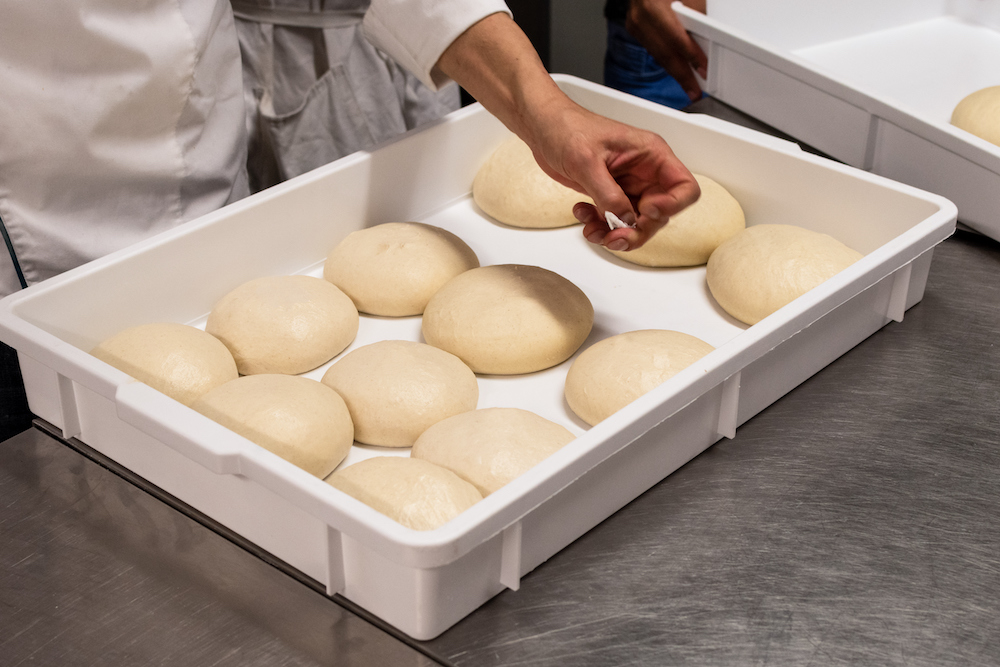Dough boxes—also referred to as dough trays—have been the industry standard for storing pizza dough balls for a very long time now. But they must be used properly to be effective.
For starters, the dough balls should be placed into the box without any oil on the bottom of the box. This will prevent the dough balls from skating around in the box if it gets tipped during handling. Otherwise, you will find all of the dough balls huddled at one end of the box, which, if not corrected, will result in the development of one giant dough ball by the end of the fermentation time. Instead, just oil the top of each dough ball after it has been placed into the box. Dough balls should be placed into the box with a 2” to 3” spacing between them; this allows for expansion of the dough during the fermentation period.
Note: Some doughs, especially those with higher absorption, may need to be spaced even further apart, as the softer dough will tend to flow out more rather than rise during fermentation.
Related: A guide to pizza dough equipment for newcomers
Once the dough balls are boxed, the boxes need to be cross-stacked in the cooler to allow for uniform cooling of the dough. Failure to cross-stack the dough boxes typically results in excessive sweating of the dough, and that leads to a sticky dough during the opening of the dough balls into skins. It can also promote bubble formation on the dough during the baking process. Additionally, failure to cross-stack the boxes will result in more variability in the rate of fermentation resulting from normal variations in finished dough temperature.
Both of the above issues can become increasingly problematic with refrigerated fermentation times in excess of 24 hours. For most of us, the dough boxes should remain cross-stacked until the internal dough-ball temperature reaches 50° to 55°F. Just be sure to always target the same temperature, not the range, as your indication to down-stack and seal the dough boxes for the duration of the fermentation period.
To be clear, when we say “down-stack,” this is the process of taking the top box and placing it on the bottom of a new stack, then orienting the boxes as you build the stack so each box becomes the sealing lid for the box under it. The top box of the stack is then covered with a lid specific to your boxes or an empty box.
If your pizza shop has a reach-in cooler instead a walk-in cooler, the cross-stacking method described above won’t work. Instead, the boxes should be placed into the rack or shelves of the reach-in cooler in a staggered manner, where alternating ends of the boxes are open and exposed to allow for air circulation around the dough balls for improved cooling. When using a reach-in cooler, it’s also advised that the finished dough temperature be targeted for something in the 70° to 75°F range to compensate for the reduced cooling efficiency of the reach-in cooler. When down-stacking for a reach-in cooler, the boxes are typically not restacked in reverse order; instead they are most often just lidded or nested in the order that they were placed in the reach-in, then allowed to ferment for the duration of the cold fermentation time.
After the cold fermentation process, the boxes should be removed from the cooler and allowed to temper at (not to) room temperature until the internal dough-ball temperature reaches 50°F. At that point, the dough balls are ready to be opened into skins for immediate use. Under typical shop conditions, the dough balls still remaining in the box at room temperature will remain good to use for a period of 2.5 to 3 hours; just be sure to keep the box lidded to prevent the dough from drying out.
What are the advantages of using dough boxes? For one thing, they are available in different colors for different days of the week or to signify different doughs contained within the box. And the boxes are available in different heights to accommodate different dough ball sizes/weights. In some cases, they’re even available in smaller sizes to fit into limited scale operations. In addition to in-store use, the dough boxes can also be used to efficiently and safely transport dough between locations, such as from a commissary to a number of stores or from one full-service store to a satellite or express store, thus saving the need for dough preparation space or equipment at the receiving store.
What are the disadvantages? Disadvantages to dough boxes include the need for regular cleaning, their initial purchase expense, and space needed for their storage. Some of the box manufacturers make special plastic scrapers designed specifically for use in their boxes. The tools have specially radiused corners to fit into and help clean the inside corners of the dough boxes, which makes for easier and faster cleaning.
The one thing you don’t want to do with plastic dough boxes is to use metal scrapers to remove the dough balls! Doing so runs the risk—in fact, the high probability—of gouging the surface. And that just makes removing the dough balls and cleaning the boxes that much more difficult!
The late, great Tom “The Dough Doctor” Lehmann was a longtime contributor to PMQ Pizza and, prior to his retirement, served as the director of bakery assistance for the American Institute of Baking.













